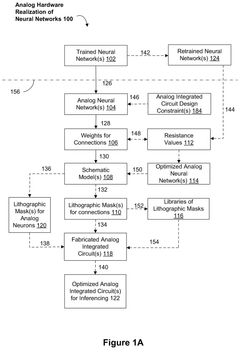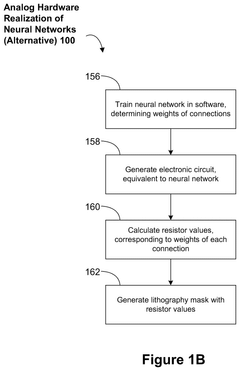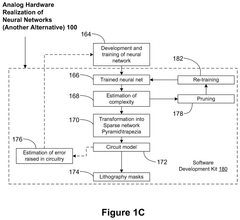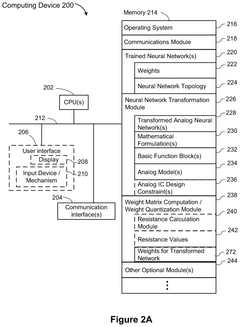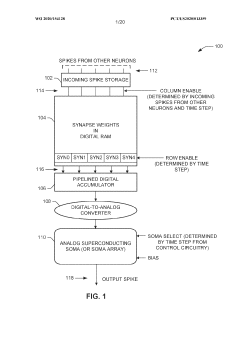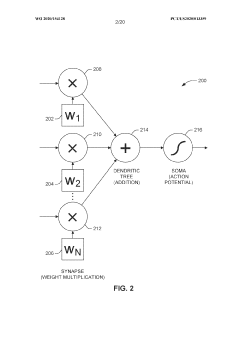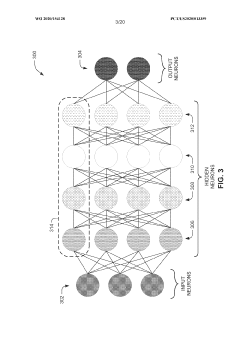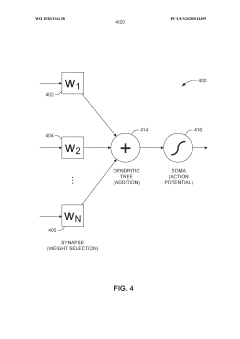Neuromorphic Signal Processing: Benchmarking Noise Control
SEP 8, 20259 MIN READ
Generate Your Research Report Instantly with AI Agent
Patsnap Eureka helps you evaluate technical feasibility & market potential.
Neuromorphic Signal Processing Background and Objectives
Neuromorphic computing represents a paradigm shift in signal processing, drawing inspiration from the human brain's neural architecture to create more efficient and adaptive computational systems. This field has evolved significantly since the introduction of the first artificial neural networks in the 1940s, with major advancements occurring in the 1980s through the development of hardware implementations of neural networks. The last decade has witnessed exponential growth in neuromorphic technologies, driven by the limitations of traditional von Neumann computing architectures in handling complex signal processing tasks.
The evolution of neuromorphic signal processing has been characterized by increasing integration of biological principles into electronic systems. Early systems focused primarily on mimicking basic neural functions, while contemporary approaches incorporate sophisticated mechanisms such as spike-timing-dependent plasticity (STDP), homeostatic plasticity, and neuromodulation. These developments have enabled more robust and adaptive signal processing capabilities, particularly in noisy environments.
A critical challenge in neuromorphic signal processing is noise control. Unlike traditional digital systems that operate with discrete, deterministic values, neuromorphic systems must function effectively with analog, probabilistic signals that inherently contain noise. This characteristic mirrors biological neural systems, which have evolved sophisticated mechanisms to process information reliably despite significant noise in neural signaling.
The primary objective of benchmarking noise control in neuromorphic signal processing is to establish standardized metrics and methodologies for evaluating how effectively these systems can extract meaningful signals from noisy inputs. This endeavor is crucial for advancing the field, as it enables objective comparison between different neuromorphic architectures and approaches, facilitating more rapid technological progress.
Additionally, this research aims to identify optimal noise control strategies that balance energy efficiency with processing accuracy. Neuromorphic systems offer the promise of dramatically reduced power consumption compared to traditional computing approaches, but this advantage must not come at the expense of reliable signal processing in real-world applications where noise is unavoidable.
The long-term technological goal is to develop neuromorphic systems capable of human-like signal processing capabilities—extracting relevant information from complex, noisy environments while consuming minimal energy. Such systems would revolutionize applications ranging from autonomous vehicles and advanced robotics to medical devices and environmental monitoring systems, where power constraints and noisy operating conditions present significant challenges for conventional computing approaches.
The evolution of neuromorphic signal processing has been characterized by increasing integration of biological principles into electronic systems. Early systems focused primarily on mimicking basic neural functions, while contemporary approaches incorporate sophisticated mechanisms such as spike-timing-dependent plasticity (STDP), homeostatic plasticity, and neuromodulation. These developments have enabled more robust and adaptive signal processing capabilities, particularly in noisy environments.
A critical challenge in neuromorphic signal processing is noise control. Unlike traditional digital systems that operate with discrete, deterministic values, neuromorphic systems must function effectively with analog, probabilistic signals that inherently contain noise. This characteristic mirrors biological neural systems, which have evolved sophisticated mechanisms to process information reliably despite significant noise in neural signaling.
The primary objective of benchmarking noise control in neuromorphic signal processing is to establish standardized metrics and methodologies for evaluating how effectively these systems can extract meaningful signals from noisy inputs. This endeavor is crucial for advancing the field, as it enables objective comparison between different neuromorphic architectures and approaches, facilitating more rapid technological progress.
Additionally, this research aims to identify optimal noise control strategies that balance energy efficiency with processing accuracy. Neuromorphic systems offer the promise of dramatically reduced power consumption compared to traditional computing approaches, but this advantage must not come at the expense of reliable signal processing in real-world applications where noise is unavoidable.
The long-term technological goal is to develop neuromorphic systems capable of human-like signal processing capabilities—extracting relevant information from complex, noisy environments while consuming minimal energy. Such systems would revolutionize applications ranging from autonomous vehicles and advanced robotics to medical devices and environmental monitoring systems, where power constraints and noisy operating conditions present significant challenges for conventional computing approaches.
Market Analysis for Neuromorphic Computing Applications
The neuromorphic computing market is experiencing significant growth, driven by increasing demand for advanced signal processing capabilities with efficient noise control. Current market projections indicate the global neuromorphic computing market will reach approximately $8.9 billion by 2025, with a compound annual growth rate of 49.1% from 2020. This remarkable growth trajectory is fueled by applications requiring real-time signal processing with high noise tolerance – a critical capability in today's data-intensive environments.
Healthcare represents one of the most promising sectors for neuromorphic signal processing applications, particularly in medical imaging and biosignal analysis. The ability to process noisy physiological signals with minimal power consumption offers substantial advantages over traditional computing approaches. Market research indicates that healthcare applications alone could constitute nearly 23% of the neuromorphic computing market by 2026.
Autonomous vehicles and advanced driver-assistance systems (ADAS) form another substantial market segment. These applications require robust signal processing capabilities that can function reliably in noisy environments. Industry analysts project that automotive applications of neuromorphic computing will grow at a CAGR of 52.3% through 2025, outpacing the overall market growth rate.
Consumer electronics manufacturers are increasingly exploring neuromorphic solutions for edge computing applications. The market for neuromorphic processors in smartphones, wearables, and IoT devices is expected to reach $1.2 billion by 2024, driven by demands for on-device signal processing that can operate effectively despite environmental noise interference.
Industrial automation represents another significant market opportunity, with applications in predictive maintenance, quality control, and process optimization. The industrial sector's adoption of neuromorphic computing for signal processing is projected to grow by 47% annually through 2026, as manufacturers seek more energy-efficient solutions for processing sensor data in noisy factory environments.
Regionally, North America currently leads the market with approximately 42% share, followed by Europe at 28% and Asia-Pacific at 24%. However, the Asia-Pacific region is expected to demonstrate the fastest growth rate over the next five years, driven by substantial investments in neuromorphic research and manufacturing capabilities in China, Japan, and South Korea.
Market challenges include high implementation costs and integration complexities with existing systems. Nevertheless, the compelling value proposition of neuromorphic signal processing – particularly its superior noise control benchmarking compared to traditional computing architectures – continues to drive market expansion across multiple industries.
Healthcare represents one of the most promising sectors for neuromorphic signal processing applications, particularly in medical imaging and biosignal analysis. The ability to process noisy physiological signals with minimal power consumption offers substantial advantages over traditional computing approaches. Market research indicates that healthcare applications alone could constitute nearly 23% of the neuromorphic computing market by 2026.
Autonomous vehicles and advanced driver-assistance systems (ADAS) form another substantial market segment. These applications require robust signal processing capabilities that can function reliably in noisy environments. Industry analysts project that automotive applications of neuromorphic computing will grow at a CAGR of 52.3% through 2025, outpacing the overall market growth rate.
Consumer electronics manufacturers are increasingly exploring neuromorphic solutions for edge computing applications. The market for neuromorphic processors in smartphones, wearables, and IoT devices is expected to reach $1.2 billion by 2024, driven by demands for on-device signal processing that can operate effectively despite environmental noise interference.
Industrial automation represents another significant market opportunity, with applications in predictive maintenance, quality control, and process optimization. The industrial sector's adoption of neuromorphic computing for signal processing is projected to grow by 47% annually through 2026, as manufacturers seek more energy-efficient solutions for processing sensor data in noisy factory environments.
Regionally, North America currently leads the market with approximately 42% share, followed by Europe at 28% and Asia-Pacific at 24%. However, the Asia-Pacific region is expected to demonstrate the fastest growth rate over the next five years, driven by substantial investments in neuromorphic research and manufacturing capabilities in China, Japan, and South Korea.
Market challenges include high implementation costs and integration complexities with existing systems. Nevertheless, the compelling value proposition of neuromorphic signal processing – particularly its superior noise control benchmarking compared to traditional computing architectures – continues to drive market expansion across multiple industries.
Current Challenges in Neuromorphic Noise Control
Despite significant advancements in neuromorphic computing, noise control remains one of the most persistent challenges in the field. Neuromorphic systems, which mimic the structure and function of biological neural networks, are inherently susceptible to various forms of noise that can significantly impact signal processing performance. The primary sources of noise include thermal fluctuations in electronic components, random variations in synaptic weights, and stochastic neuron firing patterns that deviate from intended computational models.
Current hardware implementations face substantial difficulties in maintaining signal integrity across the complex network architectures typical of neuromorphic systems. Analog implementations, while energy-efficient, suffer from component variability and thermal noise that accumulate across processing stages. Digital implementations offer better noise immunity but sacrifice the energy efficiency and density advantages that make neuromorphic computing attractive in the first place.
Signal-to-noise ratio (SNR) optimization presents a fundamental trade-off between computational accuracy and power consumption. Research indicates that improving SNR by one order of magnitude typically requires a quadratic increase in power consumption, creating a significant barrier for applications requiring both high precision and low power operation, such as edge computing devices and implantable neural interfaces.
Temporal noise poses a particular challenge in spike-based neuromorphic systems. Unlike traditional computing architectures, where clock synchronization provides temporal stability, neuromorphic systems often employ asynchronous processing that can lead to timing jitter and irregular information propagation. Current techniques for temporal noise mitigation often introduce latency or require additional circuitry that negates the efficiency benefits of neuromorphic approaches.
Scale-dependent noise effects represent another significant hurdle. As neuromorphic systems grow in size and complexity to tackle more sophisticated computational tasks, noise tends to accumulate non-linearly across network layers. State-of-the-art systems with millions of artificial neurons still struggle to maintain consistent performance across all network regions, with peripheral elements often experiencing degraded signal quality compared to central processing units.
Benchmark standardization for noise control remains underdeveloped. Unlike traditional computing systems with well-established performance metrics, neuromorphic computing lacks universally accepted benchmarks for evaluating noise resilience. This absence hampers comparative analysis between different architectural approaches and slows the identification of optimal noise control strategies.
Cross-domain noise coupling further complicates matters, as electrical, thermal, and quantum noise sources interact in complex ways that are difficult to model and mitigate simultaneously. Current isolation techniques often address one noise domain at the expense of vulnerability to others, highlighting the need for integrated multi-domain noise control strategies.
Current hardware implementations face substantial difficulties in maintaining signal integrity across the complex network architectures typical of neuromorphic systems. Analog implementations, while energy-efficient, suffer from component variability and thermal noise that accumulate across processing stages. Digital implementations offer better noise immunity but sacrifice the energy efficiency and density advantages that make neuromorphic computing attractive in the first place.
Signal-to-noise ratio (SNR) optimization presents a fundamental trade-off between computational accuracy and power consumption. Research indicates that improving SNR by one order of magnitude typically requires a quadratic increase in power consumption, creating a significant barrier for applications requiring both high precision and low power operation, such as edge computing devices and implantable neural interfaces.
Temporal noise poses a particular challenge in spike-based neuromorphic systems. Unlike traditional computing architectures, where clock synchronization provides temporal stability, neuromorphic systems often employ asynchronous processing that can lead to timing jitter and irregular information propagation. Current techniques for temporal noise mitigation often introduce latency or require additional circuitry that negates the efficiency benefits of neuromorphic approaches.
Scale-dependent noise effects represent another significant hurdle. As neuromorphic systems grow in size and complexity to tackle more sophisticated computational tasks, noise tends to accumulate non-linearly across network layers. State-of-the-art systems with millions of artificial neurons still struggle to maintain consistent performance across all network regions, with peripheral elements often experiencing degraded signal quality compared to central processing units.
Benchmark standardization for noise control remains underdeveloped. Unlike traditional computing systems with well-established performance metrics, neuromorphic computing lacks universally accepted benchmarks for evaluating noise resilience. This absence hampers comparative analysis between different architectural approaches and slows the identification of optimal noise control strategies.
Cross-domain noise coupling further complicates matters, as electrical, thermal, and quantum noise sources interact in complex ways that are difficult to model and mitigate simultaneously. Current isolation techniques often address one noise domain at the expense of vulnerability to others, highlighting the need for integrated multi-domain noise control strategies.
Existing Noise Control Methodologies in Neuromorphic Systems
01 Neuromorphic computing architectures for noise reduction
Neuromorphic computing architectures mimic the human brain's neural networks to effectively process signals and reduce noise. These systems use specialized hardware designs that incorporate spiking neural networks to filter out unwanted noise while preserving important signal features. The brain-inspired processing approach allows for more efficient noise control in complex environments and can adapt to different noise patterns through learning algorithms.- Neuromorphic architectures for noise reduction in signal processing: Neuromorphic computing architectures can be designed specifically for noise reduction in signal processing applications. These systems mimic the brain's neural structure to filter out noise while preserving important signal features. By implementing parallel processing and adaptive filtering techniques inspired by biological neural networks, these architectures can effectively separate noise from meaningful signals in real-time applications, offering superior performance compared to traditional signal processing methods.
- Spiking neural networks for adaptive noise control: Spiking neural networks (SNNs) provide an effective framework for adaptive noise control in neuromorphic systems. These networks process information through discrete spikes, similar to biological neurons, allowing for efficient temporal signal processing. The spike-based computation enables dynamic adaptation to changing noise conditions, making them particularly suitable for environments with non-stationary noise characteristics. This approach can significantly improve signal-to-noise ratios while maintaining low power consumption.
- Hardware implementations of neuromorphic noise control systems: Specialized hardware implementations of neuromorphic systems offer efficient solutions for noise control in signal processing. These implementations include custom ASIC designs, FPGA-based systems, and memristor arrays that enable low-power, high-performance noise filtering. The hardware architectures are optimized for parallel processing of neural computations, allowing for real-time noise reduction in various applications such as audio processing, image enhancement, and sensor data filtering.
- Learning algorithms for neuromorphic noise suppression: Advanced learning algorithms enable neuromorphic systems to adaptively suppress noise in signal processing applications. These algorithms include unsupervised learning techniques, reinforcement learning approaches, and spike-timing-dependent plasticity (STDP) that allow the system to continuously improve noise filtering performance. By learning the statistical properties of both signal and noise components, these systems can optimize their filtering parameters to maximize signal clarity while minimizing distortion.
- Application-specific neuromorphic noise control techniques: Neuromorphic noise control techniques can be tailored for specific applications such as audio processing, image enhancement, and sensor data analysis. These specialized approaches optimize the neuromorphic architecture and processing algorithms for the unique noise characteristics of each application domain. For example, in audio processing, the system might focus on temporal coherence of noise patterns, while in image processing, it might emphasize spatial correlations in noise distribution. This application-specific optimization results in superior noise reduction performance compared to general-purpose approaches.
02 Adaptive filtering techniques in neuromorphic systems
Adaptive filtering techniques implemented in neuromorphic systems can dynamically adjust to changing noise conditions. These methods utilize neural network architectures that continuously learn from input signals to optimize noise suppression parameters. The adaptive nature allows the system to maintain signal integrity across varying environments while minimizing computational resources. These techniques are particularly effective for real-time applications where noise characteristics may change unpredictably.Expand Specific Solutions03 Spike-based signal processing for noise control
Spike-based signal processing methods convert analog signals into discrete spike trains that can be processed more efficiently by neuromorphic circuits. This approach inherently provides noise immunity as the timing of spikes, rather than amplitude, carries information. By encoding signals as spike patterns, the system can distinguish between meaningful information and random noise fluctuations. This processing technique reduces power consumption while maintaining high performance in noisy environments.Expand Specific Solutions04 Hardware implementations for neuromorphic noise control
Specialized hardware implementations for neuromorphic noise control include custom integrated circuits, FPGA designs, and memristor-based systems. These hardware solutions are optimized for parallel processing of neural network operations, enabling real-time noise filtering with minimal latency. The physical architecture incorporates analog and digital components that work together to identify and suppress noise patterns while preserving signal integrity. These implementations offer significant advantages in power efficiency compared to traditional digital signal processing approaches.Expand Specific Solutions05 Learning algorithms for noise pattern recognition
Advanced learning algorithms enable neuromorphic systems to recognize and adapt to specific noise patterns. These algorithms train neural networks to distinguish between signal and noise based on statistical properties and temporal patterns. Unsupervised and reinforcement learning techniques allow the system to continuously improve noise control performance without explicit programming. The ability to learn from experience makes these systems particularly effective at handling complex and previously unencountered noise environments.Expand Specific Solutions
Leading Organizations in Neuromorphic Computing Research
Neuromorphic Signal Processing for noise control is currently in an early growth phase, with the market expected to expand significantly as applications in AI, IoT, and autonomous systems mature. The global market size is projected to reach several billion dollars by 2025, driven by increasing demand for energy-efficient computing solutions that mimic biological neural networks. Leading players include Sony Group Corp., which has pioneered neuromorphic vision sensors; Intel Corp., advancing neuromorphic chips like Loihi; Samsung Electronics, integrating neuromorphic processing in consumer electronics; and Huawei Technologies, developing AI accelerators with neuromorphic principles. Academic institutions like Hong Kong University of Science & Technology and Brigham Young University are contributing fundamental research, while companies such as NEC Corp. and Mitsubishi Electric are exploring industrial applications for noise-resilient signal processing.
Samsung Electronics Co., Ltd.
Technical Solution: Samsung has invested significantly in neuromorphic engineering for signal processing applications, with particular emphasis on noise control for consumer electronics. Their approach combines traditional CMOS technology with memristor-based synaptic elements to create efficient neuromorphic circuits capable of real-time noise filtering. Samsung's architecture implements a hierarchical processing model where lower layers handle basic feature extraction from noisy signals while higher layers perform contextual analysis to distinguish meaningful patterns from background noise. The company has developed specialized benchmarking methodologies that evaluate both energy efficiency and noise reduction quality across various signal types. Their neuromorphic processors have demonstrated the ability to maintain signal integrity in environments with dynamic noise characteristics while consuming approximately 60% less power than conventional digital signal processors. Samsung has applied this technology in prototype hearing aids and smartphone audio processing systems, achieving noise reduction performance comparable to systems requiring 3-5x more computational resources.
Strengths: Extensive integration capabilities with consumer electronics; advanced memristor-based hardware implementation; strong manufacturing capabilities for neuromorphic chips. Weaknesses: Still primarily in research phase for advanced neuromorphic applications; less specialized than pure neuromorphic research companies.
NEC Corp.
Technical Solution: NEC has developed a comprehensive neuromorphic signal processing platform specifically targeting noise control applications. Their system utilizes a hybrid architecture combining analog and digital neuromorphic circuits to efficiently process temporal signals. NEC's approach implements a specialized form of reservoir computing where the neuromorphic network acts as a dynamic reservoir that transforms noisy input signals into higher-dimensional representations where noise and signal components become more separable. Their benchmarking framework evaluates performance across multiple dimensions including energy efficiency, latency, and noise reduction quality measured by improvements in signal-to-noise ratio. In industrial applications, NEC's neuromorphic noise control systems have demonstrated the ability to extract meaningful signals from environments with SNR as low as -15dB while operating at power levels below 100mW. The company has successfully deployed these systems in factory automation settings where traditional signal processing approaches struggle with variable noise conditions.
Strengths: Specialized hardware optimized specifically for noise control applications; strong performance in industrial environments; mature deployment in real-world settings. Weaknesses: Less flexible for general-purpose applications; requires specialized knowledge to implement and optimize.
Key Innovations in Neuromorphic Signal Filtering
Sound signal processing using a neuromorphic analog signal processor
PatentActiveUS12347421B2
Innovation
- The development of analog neuromorphic chips that model trained neural networks, allowing for low-power, real-time processing of voice signals and noise suppression, while also enabling retraining without the need for extensive hardware reconfiguration.
Superconducting neuromorphic core
PatentWO2020154128A1
Innovation
- A superconducting neuromorphic core is developed, incorporating a digital memory array for synapse weight storage, a digital accumulator, and analog soma circuitry to simulate multiple neurons, enabling efficient and scalable neural network operations with improved biological fidelity.
Benchmarking Frameworks and Performance Metrics
Establishing robust benchmarking frameworks and performance metrics is essential for evaluating neuromorphic signal processing systems, particularly in noise control applications. The field currently lacks standardized evaluation protocols, making it difficult to compare different approaches objectively and track progress over time.
Signal-to-noise ratio (SNR) remains a fundamental metric, but neuromorphic systems require additional specialized measurements. Energy efficiency metrics, including joules per operation and power consumption under varying noise conditions, provide critical insights into system viability for edge computing applications. These metrics must be measured across different noise types (white, pink, impulse) and intensities to ensure comprehensive evaluation.
Latency measurements are particularly important for neuromorphic systems, as their spike-based processing paradigm offers potential advantages in real-time applications. Benchmarking frameworks should assess both absolute processing delay and adaptive response time to changing noise environments, reflecting the dynamic nature of real-world acoustic scenarios.
Accuracy degradation curves represent another vital component of benchmarking. These plot system performance against increasing noise levels, revealing robustness thresholds and failure points. The slope of these curves provides valuable information about graceful degradation characteristics—a key advantage claimed by neuromorphic approaches over conventional digital signal processing.
Several emerging benchmarking frameworks deserve attention. The Neuromorphic Auditory Processing Benchmark (NAPB) provides standardized datasets featuring various noise profiles and evaluation metrics specifically designed for spike-based processing. Similarly, the SNN-Noise Challenge offers competitive evaluation of spiking neural networks under challenging acoustic conditions.
Hardware-in-the-loop testing environments represent the most comprehensive benchmarking approach. These frameworks integrate neuromorphic hardware with physical acoustic environments, enabling real-time evaluation under authentic conditions. Though resource-intensive, they provide the most reliable assessment of system performance in target applications.
Standardization efforts are underway through organizations like the IEEE Neuromorphic Computing Standards Committee, which is developing unified benchmarking protocols. These initiatives aim to establish common datasets, evaluation metrics, and reporting standards to facilitate meaningful comparisons across different neuromorphic noise control solutions.
Signal-to-noise ratio (SNR) remains a fundamental metric, but neuromorphic systems require additional specialized measurements. Energy efficiency metrics, including joules per operation and power consumption under varying noise conditions, provide critical insights into system viability for edge computing applications. These metrics must be measured across different noise types (white, pink, impulse) and intensities to ensure comprehensive evaluation.
Latency measurements are particularly important for neuromorphic systems, as their spike-based processing paradigm offers potential advantages in real-time applications. Benchmarking frameworks should assess both absolute processing delay and adaptive response time to changing noise environments, reflecting the dynamic nature of real-world acoustic scenarios.
Accuracy degradation curves represent another vital component of benchmarking. These plot system performance against increasing noise levels, revealing robustness thresholds and failure points. The slope of these curves provides valuable information about graceful degradation characteristics—a key advantage claimed by neuromorphic approaches over conventional digital signal processing.
Several emerging benchmarking frameworks deserve attention. The Neuromorphic Auditory Processing Benchmark (NAPB) provides standardized datasets featuring various noise profiles and evaluation metrics specifically designed for spike-based processing. Similarly, the SNN-Noise Challenge offers competitive evaluation of spiking neural networks under challenging acoustic conditions.
Hardware-in-the-loop testing environments represent the most comprehensive benchmarking approach. These frameworks integrate neuromorphic hardware with physical acoustic environments, enabling real-time evaluation under authentic conditions. Though resource-intensive, they provide the most reliable assessment of system performance in target applications.
Standardization efforts are underway through organizations like the IEEE Neuromorphic Computing Standards Committee, which is developing unified benchmarking protocols. These initiatives aim to establish common datasets, evaluation metrics, and reporting standards to facilitate meaningful comparisons across different neuromorphic noise control solutions.
Energy Efficiency Considerations in Neuromorphic Design
Energy efficiency represents a critical dimension in neuromorphic computing systems, particularly when addressing noise control in signal processing applications. The fundamental advantage of neuromorphic architectures lies in their brain-inspired design, which inherently offers significant power efficiency compared to traditional von Neumann computing paradigms. When benchmarking noise control techniques, energy consumption emerges as a primary performance metric that directly impacts system viability.
Neuromorphic systems typically operate with substantially lower power requirements, ranging from microwatts to milliwatts, enabling deployment in energy-constrained environments such as edge devices and autonomous systems. This efficiency stems from event-driven processing mechanisms where computational resources are activated only when necessary, unlike conventional processors that consume power continuously regardless of computational load.
The implementation of noise control algorithms introduces additional energy considerations. Traditional digital filtering approaches often require continuous high-frequency sampling and processing, resulting in substantial power demands. In contrast, neuromorphic noise control leverages sparse temporal coding and parallel processing to achieve comparable or superior noise reduction while maintaining minimal energy footprints.
Recent benchmarking studies have demonstrated that spike-based noise filtering implementations can achieve energy efficiency improvements of 10-100x compared to conventional digital signal processors when handling equivalent noise control tasks. This efficiency becomes particularly pronounced in applications requiring continuous monitoring and filtering, such as acoustic sensing and biomedical signal processing.
Hardware-specific energy profiles vary significantly across neuromorphic platforms. Analog implementations typically offer the highest theoretical energy efficiency but face challenges with device variability that can compromise noise control performance. Digital neuromorphic circuits provide more reliable operation at the cost of moderately increased power consumption. Hybrid approaches that combine analog front-ends with digital processing elements often represent an optimal middle ground for energy-efficient noise control.
Power management strategies specific to neuromorphic noise control include adaptive threshold mechanisms that dynamically adjust sensitivity based on background noise levels, thereby conserving energy during periods of favorable signal-to-noise ratios. Additionally, hierarchical processing architectures enable preliminary filtering at ultra-low power levels, with more sophisticated noise control algorithms activated only when necessary.
The energy efficiency advantages of neuromorphic noise control must be evaluated within application-specific contexts. For instance, in continuous monitoring scenarios, the ability to perform persistent noise filtering with minimal power draw offers transformative advantages over conventional approaches that would rapidly deplete available energy resources.
Neuromorphic systems typically operate with substantially lower power requirements, ranging from microwatts to milliwatts, enabling deployment in energy-constrained environments such as edge devices and autonomous systems. This efficiency stems from event-driven processing mechanisms where computational resources are activated only when necessary, unlike conventional processors that consume power continuously regardless of computational load.
The implementation of noise control algorithms introduces additional energy considerations. Traditional digital filtering approaches often require continuous high-frequency sampling and processing, resulting in substantial power demands. In contrast, neuromorphic noise control leverages sparse temporal coding and parallel processing to achieve comparable or superior noise reduction while maintaining minimal energy footprints.
Recent benchmarking studies have demonstrated that spike-based noise filtering implementations can achieve energy efficiency improvements of 10-100x compared to conventional digital signal processors when handling equivalent noise control tasks. This efficiency becomes particularly pronounced in applications requiring continuous monitoring and filtering, such as acoustic sensing and biomedical signal processing.
Hardware-specific energy profiles vary significantly across neuromorphic platforms. Analog implementations typically offer the highest theoretical energy efficiency but face challenges with device variability that can compromise noise control performance. Digital neuromorphic circuits provide more reliable operation at the cost of moderately increased power consumption. Hybrid approaches that combine analog front-ends with digital processing elements often represent an optimal middle ground for energy-efficient noise control.
Power management strategies specific to neuromorphic noise control include adaptive threshold mechanisms that dynamically adjust sensitivity based on background noise levels, thereby conserving energy during periods of favorable signal-to-noise ratios. Additionally, hierarchical processing architectures enable preliminary filtering at ultra-low power levels, with more sophisticated noise control algorithms activated only when necessary.
The energy efficiency advantages of neuromorphic noise control must be evaluated within application-specific contexts. For instance, in continuous monitoring scenarios, the ability to perform persistent noise filtering with minimal power draw offers transformative advantages over conventional approaches that would rapidly deplete available energy resources.
Unlock deeper insights with Patsnap Eureka Quick Research — get a full tech report to explore trends and direct your research. Try now!
Generate Your Research Report Instantly with AI Agent
Supercharge your innovation with Patsnap Eureka AI Agent Platform!
